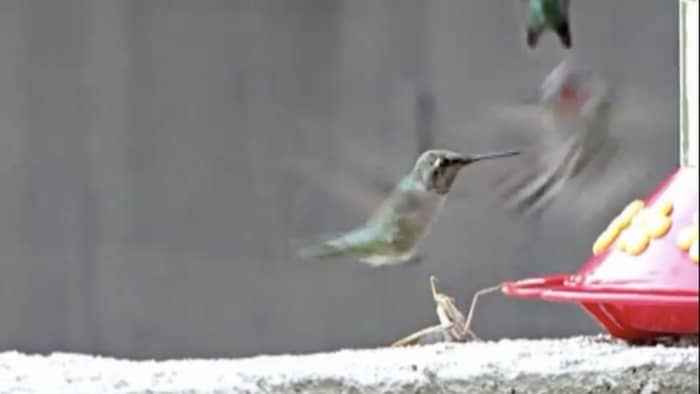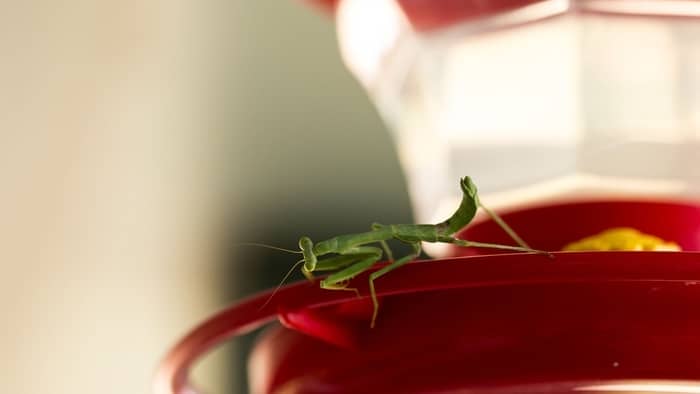Ever wondered if a praying mantis is capable of killing a bird or even a hummingbird? Praying mantis is a type of insect themselves that tends to feed mostly on other small insects. Therefore, they are predatory insects.
But don’t be deceived. These predatory insects can get greedy and prey on other creatures apart from insects. They have been known to feed on small lizards, mice, frogs, and even small birds. Therefore, praying mantis has been known to be capable of attacking hummingbirds and even preying on them.
This article will give some details about praying mantis attacking and even killing a hummingbird.
Praying Mantis
The praying mantis is a type of insect that belongs to the family of grasshoppers. They are also closely related to crickets and cockroaches.
They are characterized by their long and thin body and they have these huge eyes. Their front legs are enormous and they utilize them in catching their prey such as insects. They are green in color which gives them the ability to camouflage.

They are referred to as praying mantis because of the shape of their prominent legs which are bent and held together at an angle that looks like a praying position.
Some mantis insects can be as long as 5 to 6 inches and this is in fact longer than a small hummingbird species that are usually around 4 inches.
Praying mantis are formidable creatures that can explore any prey they feel they can catch. They will stay still or motionless and allow any prey to come to close their range where they can easily grab and reach their prey unannounced.
They make use of their forearms and they utilize their legs to hold down their prey. Then they utilize their sharp jaw to eat their prey.
Do Praying Mantis Eat Hummingbirds?
Even though there have been different reports of praying mantis feeding on small lizards and small amphibians, there have also been some reports on them feeding on hummingbirds.
Praying mantis has been seen attacking and feeding on hummingbirds. But this is usually common with praying mantis that is big in size (about 5 to 6 inches long) to be able to prey on a small hummingbird.
Also, praying mantis that is on the larger side tends to prey on creatures that are twice as big as they are. This makes them very daring and formidable insect prey.
When praying mantis catches its prey, it devours parts of its prey and discards the rest of the undesirable parts. This insect predator prefers to feed on the blood, brain, and organs of the bird. Then it discards or leaves the rest of the bird such as feathers, bills, bones, feet, and others.
So, when it comes to praying mantis vs hummingbird, this insect prey can still attack hummers even with their small size.
Why A Praying Mantis May Prey On Hummingbird
We know that praying mantis are mainly insects predators. But why would they diverge and go for other creatures such as small birds, amphibians, and so on?
The reason why praying mantis may decide to feed on other creatures such as hummingbird may be because it is very hungry.
However, the mantis isn’t capable of eating the entire bird. But if praying mantis has probably gone days without food and it comes across a hummingbird, it can be inclined to prey on the hummingbird.
But generally speaking, praying mantis tends to go after fast-moving insect preys such as bees and wasps. Now hummingbirds are also fast-moving creatures so hummers may look enticing to praying mantis. The hungry insect prey can then attack hummingbirds even before it realizes the size of the fast hummingbird it has preyed on.

Ways To Protect Our Hummers From Preying Mantis
Praying insects preying or feasting on hummingbirds can call for concern for us birders. It is therefore important we imbibe ways to protect our sweet feathered friends from falling prey to praying mantis.
Praying mantis is majorly found sitting and camouflaging on foliage. They can find spots these hiding spots near your feeders in anticipation of some quick prey to feed on.
The good news is that there are some measures you can imbibe to discourage praying mantis from hanging around your feeders. They include:
1. Hang feeders in the open
When hanging your feeders, choose a spot that is open. The spot should be far away from low-hanging shrubs and trees. So they won’t have the chance of hiding or hanging within shrubs. However, they may still hang over your feeders.
But this will at least give hummingbirds a clear view and warning of any danger loitering around.
2. Keep bees and wasps away by keeping feeders clean
Praying mantises are insects’ prey. Their major preys are small and fast insects such as bees, hornets, and wasps. Therefore, try as much as possible to keep bees, wasps, and other insects away from your feeders so you don’t attract praying mantis to your feeders.
Clean feeders frequently and seal up any cracks or leaks. You can also make use of bee guards to discourage bees. Additionally, don’t use yellow feeders and get rid of any yellow colors near your feeders as bees are attracted to yellow.
3. Pick and remove them
If you sight any praying mantis around your feeders, simply pick them and remove them. Then put them away in another spot in your garden far away from your feeder. Praying mantises are actually useful around especially around your vegetable gardens.
4. Bird feeder cover
You can also make use of a wide feeder bird cover or a special dome around your feeder. This helps in deterring and discouraging praying mantis from sitting on your hummingbird feeders. It will still allow hummingbirds to have access to your feeders.

Praying Mantis killing Hummingbird: Conclusion
Praying mantis killing hummingbird is not unheard of. They have been sighted attacking and preying on hummingbirds. So, if you’ve encountered praying mantis attacking hummingbirds around your yard, we encourage you to put in measures to keep your hummingbird safe.
We have listed some things you can do to keep your hummingbird safe from praying mantis. So be sure to follow them.

